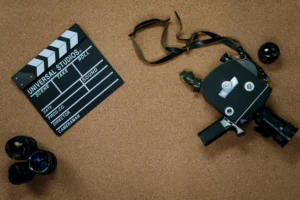When did filmmaking Start?
Trip Through Cinema’s Beginning

One of the most powerful means of narrative available in contemporary society is filmmaking. From personal small films to big-budget Hollywood blockbusters, the cinematic experience still enthralls viewers all over. But when did it start? From a scientific curiosity, how did moving images transform into a cultural phenomenon?
To respond to this issue, we have to go back to the 19th century when cinema first emerged from the desire to depict life in motion, invention, and curiosity set off its path.
Laying the Groundwork: The Pre-Film Era
People have long looked for ways to show motion before watching movies. Cave paintings depicted moving sequences; shadow puppets, magic lanterns, and flipbooks delighted viewers with lifelike illusions. But the basis for contemporary cinema wasn’t set by photography until the 19th century.
1. The invention of photography (1820s–1830s)
Using heliography, Joseph Nicéphore Niépce produced the first-ever permanent image in the 1820s. Louis Daguerre improved the technique with the daguerreotype, therefore enabling more accessible photography. These technical advancements enabled still picture capturing of the actual environment.
2. Eadweard Muybridge’s (1878) motion study
When British-American photographer Eadweard Muybridge effectively caught the movement of a galloping horse using many cameras in 1878, the idea of motion pictures underwent a radical shift. His motion photography, especially his series The Horse in Motion, was essential in proving that motion could be disassembled into a sequence of still pictures and then rebuilt.
The beginning of film late in the 1800s
Photography, mechanics, and invention came together in the late 19th century. Engineers hurried to design devices that were able to record and show motion pictures.
1. Thomas Edison’s Kinetoscope (1891)
Thomas Edison and his helper William Kennedy Laurie Dickson created the Kinetoscope in the United States, a tool enabling one person at a time to view moving pictures. Dickson Greeting was a short film shot taken at the Edison lab in 1891, the first motion picture there. Though groundbreaking, the Kinetoscope only lets one view at once.
2. Lumière Brothers and Cinematograph 1895
Auguste and Louis Lumière transformed public cinema watching in France, while Edison set the foundation for the United States. They unveiled the Cinématographe in 1895, a camera with projection capability. They first publicly showed a film to a paid audience at the Grand Café in Paris on December 28, 1895.
Among the various little films in the program were Workers Leaving the Lumière Factory and The Arrival of a Train at La Ciotat Station. The latter was so lifelike that, according to folklore, several spectators leaped in panic, believing the train would pass right through the screen.
This occasion launches movies as a public entertainment tool.
The Quiet Age (1895–1927)
Film methods, narrative, and technology advanced rapidly throughout the following three decades. Movies without synchronized sound during this silent cinema period sometimes included live music and intertitles (text between scenes).
- Early filmmakers like Georges Méliès (A Trip to the Moon, 1902) started narrating creative, regimented tales.
- Pioneers such as Edwin S. Porter (The Great Train Robbery, 1903) introduced continuity and cross-cutting editing.
- Hollywood Emergence: American films had migrated to California by the 1910s, when Warner Bros., Universal, and Paramount started to rule.
- Silent movies set the creative basis for contemporary filmmaking and created worldwide stars such as Mary Pickford, Charlie Chaplin, and Buster Keaton.
Sound Revolution: “Talkies” Start (1927)

With the release of The Jazz Singer, the first feature-length movie with synced speech, cinema underwent the most drastic change in 1927. Though just a few sequences had spoken words, it highlighted the promise of “talkies” and indicated the fall-off in silent films.
Most movies included sound within a few years, which meant adjustments in acting, directing, and production. Studios started funding sound technologies, and viewers soon became used to hearing their preferred actors on film.
Color, Special Effects, and World Cinema (1930s–1950s)
Following good taste, color became the next front line. Although early color technologies like Kinemacolor and two-color Technicolor were developed in the 1910s and 1920s, color movies did not start to make sense economically until the late 1930s.
Important Events:
- Gone with the Wind (1939) and The Wizard of Oz (1939) highlighted Technicolor’s promise.
- Propaganda movies as well as the expansion of foreign movies were shaped by World War II.
- Strong national cinema industries started to grow in nations such as India, Italy, and Japan.
Modern Video and the Digital Age (1960s–Today)
Filming would change often during the following few decades:
- 1960s–1980s: Blockbusters (Jaws, Star Wars), rise of auteur filmmakers (e.g., Stanley Kubrick, Akira Kurosawa, François Truffaut), and independent cinema.
- Digital editing techniques and CGI innovations (Jurassic Park, The Matrix) define the 1990s.
- 2000s–2020s: The digital revolution—high-definition cameras, streaming platforms, virtual production techniques—e.g., The Mandalorian—is underway.
From virtual reality experiences to drones and AI-enhanced editing, modern filmmaking combines cutting-edge technology with classic narrative.
Conclusion
In summary, a chronology of the film’s development
In essence, these are important turning points in the Evolution of movies:
Year Milestone: 1878 Muybridge’s motion photography; 1891 Edisons’s Kinetoscope
1895: First public showing by Lumière brothers
2003: Editing narratives in The Great Train Robbery
2727: First “talkie,” or The Jazz Singer
1939: Technicolor finds popularity (The Wizard of Oz)
1993: CGI masterwork in Jurassic Park 2007+ Evolution of virtual production, digital movies, and streaming media.
Originally driven by scientific curiosity, what today is a worldwide cultural force. Though its roots remain evidence of human creativity and the need to relate tales, film is always changing.
Common Questions About Filmmaking’s Beginning
1. The man credited with founding the film is
Although many helped to shape movies, the Lumière brothers are usually credited with creating cinema as a public art form because of their 1895 Cinématographe short film exhibition.
2. Was the first film ever produced?
Roundhay Garden Scene (1888) by Louis Le Prince is the first motion film that has survived. Though officially the first moving picture taken on film, it is barely a few seconds long and depicts people strolling in a garden.
3. Early on in movies, did sound feature?
Released in 1927, The Jazz Singer was the first feature-length movie featuring synchronized speech. It launched the sound era in movies.
4. Why did producers go to Hollywood?
Hollywood gave filmmakers greater flexibility by providing continuous sunny weather, various settings for shooting, and distance from Thomas Edison’s East Coast film patents.
- When did standard color films come about?
With Technicolor helping to bring masterpieces like The Wizard of Oz (1939) alive, color pictures gained great popularity in the late 1930s and early 1940s.